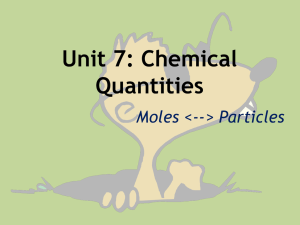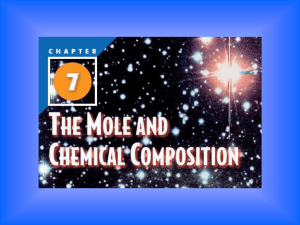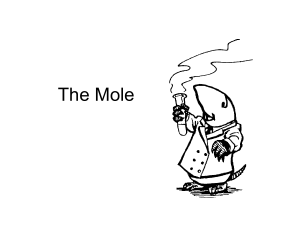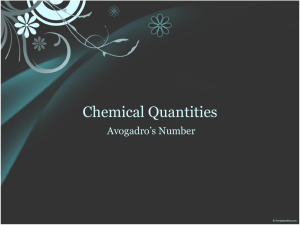Avogadro`s constant and the mole
advertisement
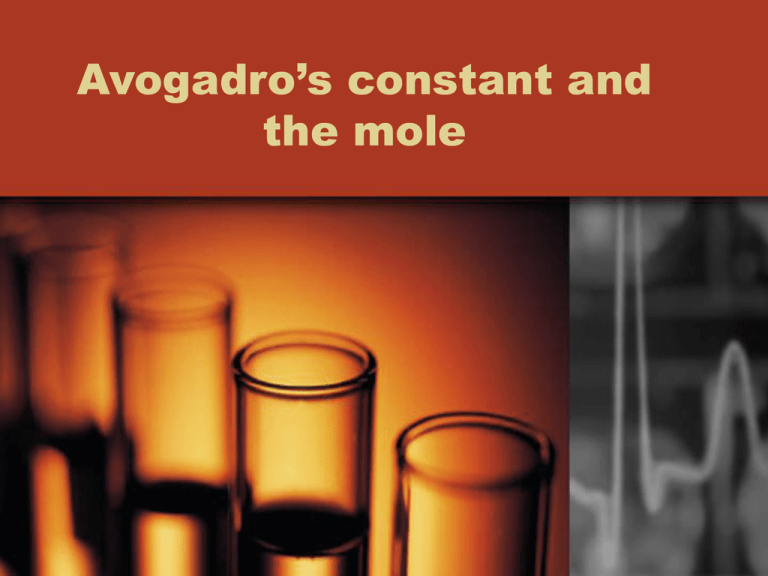
Avogadro’s constant and the mole • Mass on its own is not very useful because when reactions take place they depend on # of atoms not their mass. • Atoms are way to small and numerous to count so you need a way to relate # of atoms to masses that can be measured The Mole • People find it easier and useful to work in groups when counting Pair=2 Dozen=12, Gross=144 • To count the number of atoms a dozen or gross isn’t large enough since elements contain a huge # of atoms • Instead chemist use the mole (symbol mol) The Mole • The amount of substance that contains 6.02214199X1023 particles(atoms, molecules, formula units) of that substance • This is called Avogadro Constant • Has the symbol NA • Rarely need 9 sig figs when working with the number so 3 is enough • NA=6.02X1023mol-1 Examples • One mole of carbon contains 6.02X1023 carbon atoms • One mole of Magnesium Chloride contains 6.02X1023 formula units of MgCl • Etc Application • When someone ask you to buy them 2 dozen eggs, they are also thinking of 24 eggs 2dozen X 12eggs=24eggs 1dozen • You can convert between moles and particles in the same way 2molX6.02X1023atoms=1.20X1024atoms mol Converting moles to # of particles • Moles are used to help us count atoms and molecules # of moles Multiply by 6.02X1023 # of particles (atoms, molecules, formula units) • Relationship can be written using formula below Where: N=# of particles n= amount(mols) • N=n X NA NA= Avogadro's constant(mol-1) Converting # of particles to moles • Usually express in moles • To convert # of particles in a substance to number of moles, just rearrange the formula learned on pervious slide N= n X NA rearranges to n= N/NA Example • How many moles are present in a sample of potassium floride, KF, made up of 5.83X1024 molecules? Solution: To solve we use Avogadro constant and the number of molecules given and substitute into equation: n= 5.83X1024 molecules KF 6.02X1023 molecules KF/mol KF n=9.68mol KF So there are 9.68 moles of KF in the sample Converting from moles to mass • Suppose you were asked to weigh out three moles of a substance • In order to do so you must figure out how much 3 moles is in grams to use the scale • The formula below relates moles and mass by molar mass • Mass=#of moles X molar mass • m= n X M where m=mass n=# moles M=molar mass Example • A flask contains 0.750 mol of carbon dioxide gas. What mass of CO2 gas is in this sample? • First we must find the molar mass of CO2 to use in the equation along with the # of moles that was given • 1Carbon + 2Oxygen 12.01g/mol+2(16.00g/mol)=44.01g/mol • Using the equation m=n X M m= 0.750molX44.01g/mol m=33g of CO2 in 0.750mol of CO2 Converting from mass to moles • Opposite of moles to mass • Use formula below • Mol= mass or n= m molar mass M Example • How many moles of acetic acid, CH3COOH, are there in a 23.6g sample? • First need to find molar mass: • There are 2C, 2O, and 4H M=2(12.01g/mol)+(2(16g/mol)+4(1.01g/mol) M=60.06g/mol • Next substitute values into equation n=m/M n= 23.6g n= 0.393mol of CH3COOH in 60.06g/mol 23.6g of CH3COOH Time to practice!


